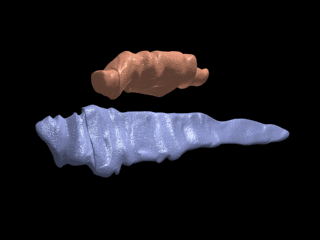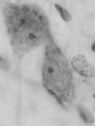







 |
 |
|
 |
 |
 |
 |
 |
 |
CURRENT PROJECTS
![]()
 1.
ORGANIZATION OF PERIOLIVARY NUCLEI IN THE HUMAN SOC
1.
ORGANIZATION OF PERIOLIVARY NUCLEI IN THE HUMAN SOC
The working hypothesis for this project is: since human hearing sensitivity
is focused in the low frequency range (20Hz to 20kHz), the human SOC should
contain a compliment of PON rivaling those of other low-frequency hearing
animals (e.g. chinchilla). Since it has been shown that inhibition arising
from the MNTB and LNTB are important for processing of low frequency sounds
(Brand et al., 2002), the human PON should include a prominent MNTB and LNTB.
The purpose of this project is to provide an initial characterization of periolivary
nuclei in human as a basis for further study. Periolivary nuclei in the human
SOC will be examined in Nissl or cytochrome oxidase stained material. Additionally,
estimates of neuronal number will be made and the constituent neurons in each
nucleus will be classified and catalogued for future reference.

Original 3D model data
compiled by Dr. Randy Kuleza
3D rendering and enhancement by Maher Al-Samkari
![]()
 2.
DISTRIBUTION OF INHIBITORY NEUROTRANSMITTERS WITHIN THE HUMAN SOC
2.
DISTRIBUTION OF INHIBITORY NEUROTRANSMITTERS WITHIN THE HUMAN SOC
The working hypothesis for this project is: human periolivary nuclei serve
fine-tuning or modulatory roles in auditory processing and this function is
carried out via inhibitory mechanisms. This requires that periolivary nuclei
are inhibitory and therefore use inhibitory neurotransmitters (primarily GABA
or glycine but also dopamine and acetylcholine). The purpose of this project
is to characterize the distribution of cholinergic, dopaminergic, GABAergic
and glycinergic neurons and punctate profiles (presumably representing synaptic
terminals) in the human SOC. Additionally, estimates will be made of the number
of neurons within each PON using inhibitory neurotransmitters.
![]()
 3.
STRUCTURAL FEATURES OF THE CALYX OF HELD
3.
STRUCTURAL FEATURES OF THE CALYX OF HELD
The working hypothesis for this project is: humans use similar neuronal circuits
for sound processing as other mammals. Integral to these pathways are PON
that receive the calyx of Held a large, secure synaptic ending from the cochlear
nucleus. The calyx plays an essential role in temporal processing and localization
of sound sources. Interestingly, current descriptions of the human SOC deny
this population. The purpose of this project is to determine, using immunocytochemistry
for various calcium binding proteins, if these specialized endings are present
in the human SOC and what PON neurons are receiving calyceal innervation.
The experiments in this project will conclusively confirm or negate the presence
of this important neuronal circuit.
![]()
COLLABORATIONS
![]()
1. IN-VIVO RECORDINGS FROM SUPERIOR PARAOLIVARY NUCLEUS OF RAT
- A collaboration with Dr. Berrebi (WVU)
2. NEUROCHEMICAL PROFILES IN THE HUMAN SPINAL TRIGEMINAL NUCLEUS
- A Collaboration with Drs. Rowland and Wells (SIUE)